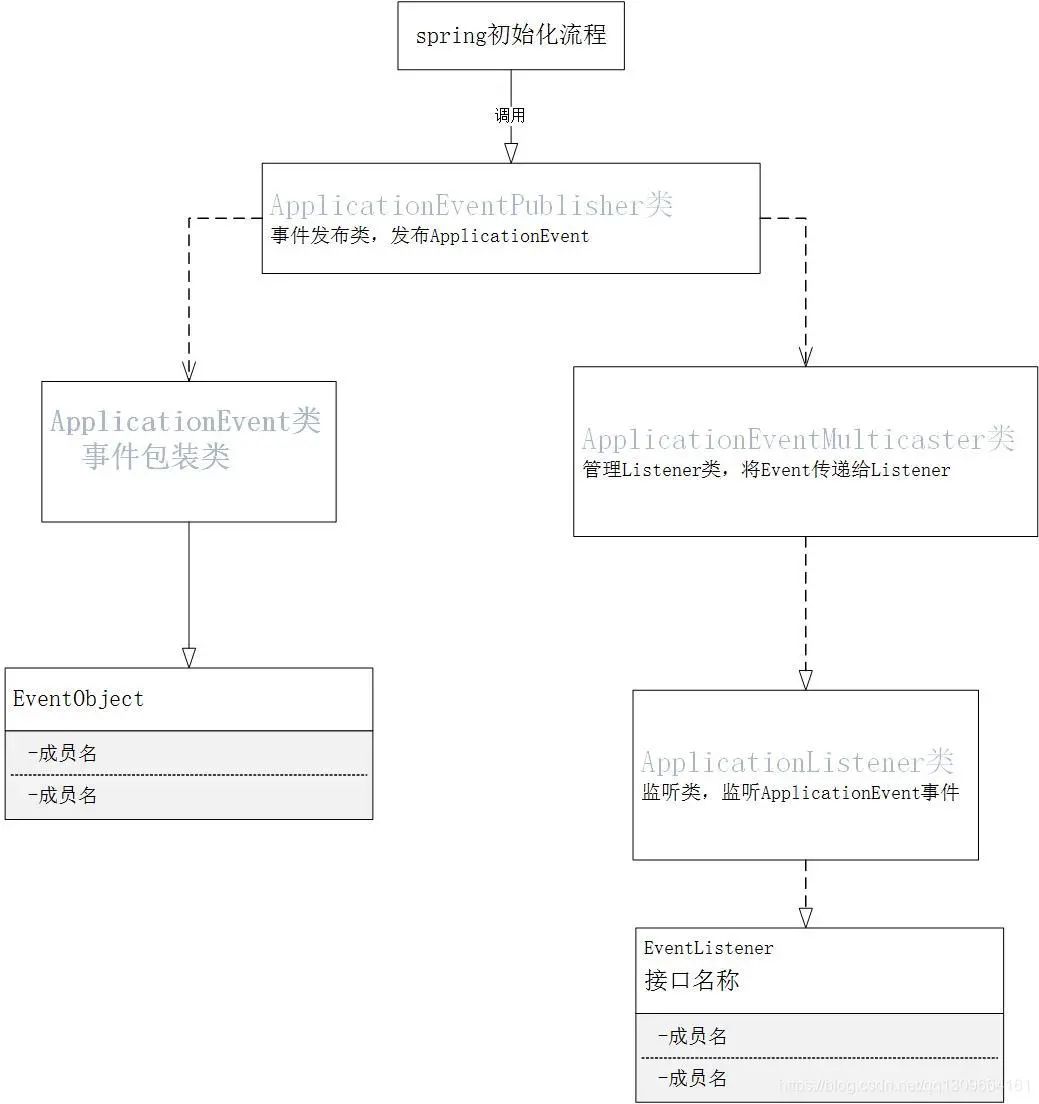Spring之事件机制详解
点击上方蓝色字体,选择“标星公众号”
优质文章,第一时间送达
机制详解
public interface ApplicationEventMulticaster {
/**
* Add a listener to be notified of all events.
* @param listener the listener to add
*/
void addApplicationListener(ApplicationListener<?> listener);
/**
* Add a listener bean to be notified of all events.
* @param listenerBeanName the name of the listener bean to add
*/
void addApplicationListenerBean(String listenerBeanName);
/**
* Remove a listener from the notification list.
* @param listener the listener to remove
*/
void removeApplicationListener(ApplicationListener<?> listener);
/**
* Remove a listener bean from the notification list.
* @param listenerBeanName the name of the listener bean to remove
*/
void removeApplicationListenerBean(String listenerBeanName);
/**
* Remove all listeners registered with this multicaster.
* <p>After a remove call, the multicaster will perform no action
* on event notification until new listeners are registered.
*/
void removeAllListeners();
/**
* Multicast the given application event to appropriate listeners.
* <p>Consider using {@link #multicastEvent(ApplicationEvent, ResolvableType)}
* if possible as it provides better support for generics-based events.
* @param event the event to multicast
*/
void multicastEvent(ApplicationEvent event);
/**
* Multicast the given application event to appropriate listeners.
* <p>If the {@code eventType} is {@code null}, a default type is built
* based on the {@code event} instance.
* @param event the event to multicast
* @param eventType the type of event (can be {@code null})
* @since 4.2
*/
void multicastEvent(ApplicationEvent event, @Nullable ResolvableType eventType);
}
public interface ApplicationEventPublisher {
/**
* Notify all <strong>matching</strong> listeners registered with this
* application of an application event. Events may be framework events
* (such as ContextRefreshedEvent) or application-specific events.
* <p>Such an event publication step is effectively a hand-off to the
* multicaster and does not imply synchronous/asynchronous execution
* or even immediate execution at all. Event listeners are encouraged
* to be as efficient as possible, individually using asynchronous
* execution for longer-running and potentially blocking operations.
* @param event the event to publish
* @see #publishEvent(Object)
* @see org.springframework.context.event.ContextRefreshedEvent
* @see org.springframework.context.event.ContextClosedEvent
*/
default void publishEvent(ApplicationEvent event) {
publishEvent((Object) event);
}
/**
* Notify all <strong>matching</strong> listeners registered with this
* application of an event.
* <p>If the specified {@code event} is not an {@link ApplicationEvent},
* it is wrapped in a {@link PayloadApplicationEvent}.
* <p>Such an event publication step is effectively a hand-off to the
* multicaster and does not imply synchronous/asynchronous execution
* or even immediate execution at all. Event listeners are encouraged
* to be as efficient as possible, individually using asynchronous
* execution for longer-running and potentially blocking operations.
* @param event the event to publish
* @since 4.2
* @see #publishEvent(ApplicationEvent)
* @see PayloadApplicationEvent
*/
void publishEvent(Object event);
}
领悟
应用
@Component
public class MyEventSource {
public void ccc(){
System.out.println("事件源方法");
}
}
@Component
public class MyEvent extends ApplicationEvent {
public MyEvent(MyEventSource source) {
super(source);
}
public void eventMethod(){
System.out.println("事件自定义方法");
}
}
@Component
public class MyListener implements ApplicationListener {
@Override
public void onApplicationEvent(ApplicationEvent applicationEvent) {
if(applicationEvent instanceof MyEvent) {
((MyEvent)applicationEvent).eventMethod();
MyEventSource eventSource = (MyEventSource) applicationEvent.getSource();
eventSource.ccc();
System.out.println("监听者发生一些改变");
}
}
}
public class MyTest {
@Test
public void test1() {
ClassPathXmlApplicationContext applicationContext = new ClassPathXmlApplicationContext("spring.xml");
Object o=applicationContext.getBean("myEvent");
applicationContext.publishEvent(applicationContext.getBean("myEvent"));
}
}
总结
补充:
@Component
public class MyListener implements ApplicationListener<ContextRefreshedEvent> {
@Override
public void onApplicationEvent(ContextRefreshedEvent event) {
while (true){
System.out.println("执行业务");
}
}
}
作者 | 敲代码的小小酥
来源 | csdn.net/qq1309664161/article/details/119025323

评论

